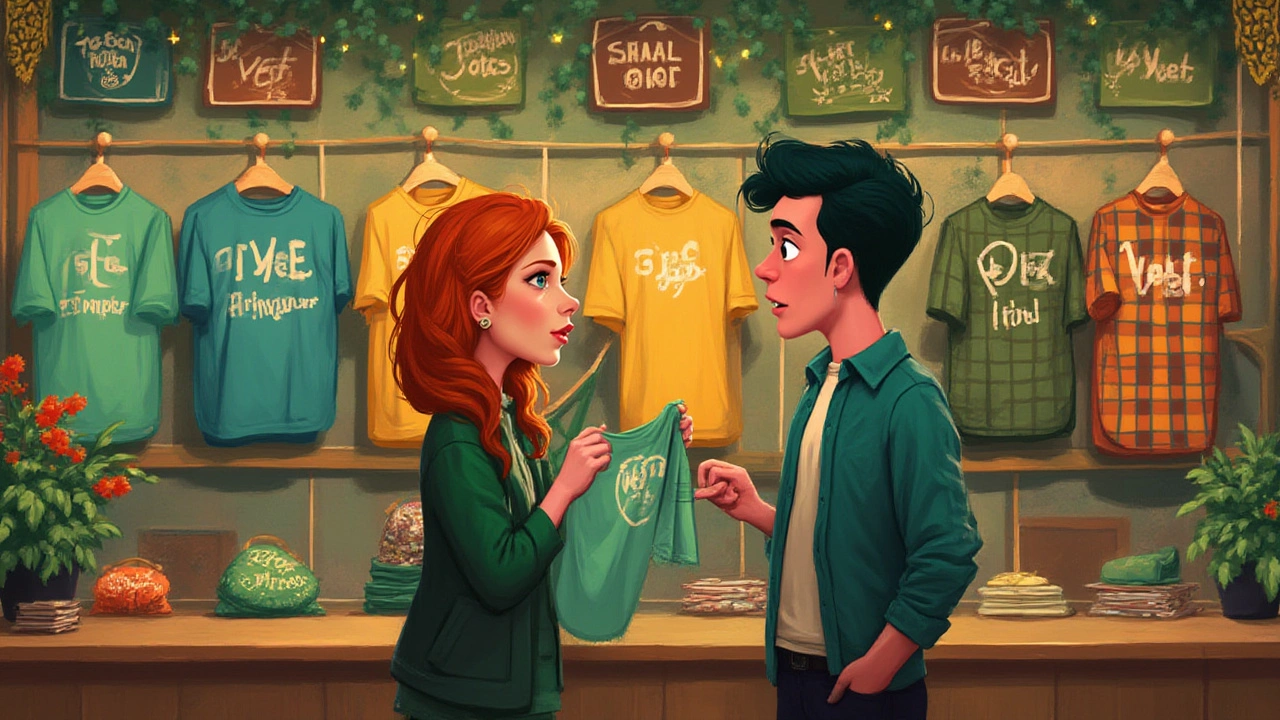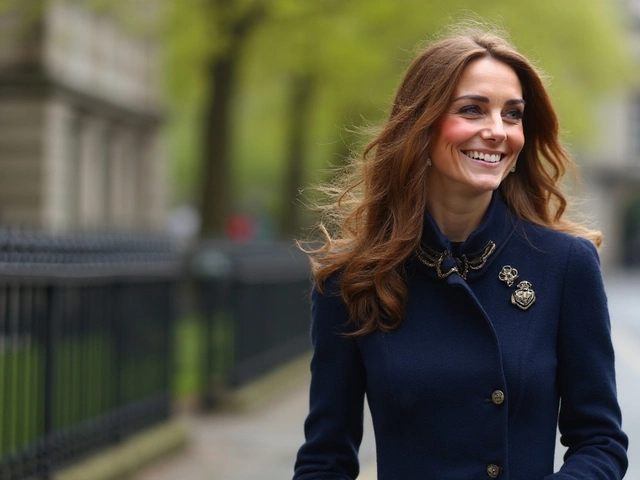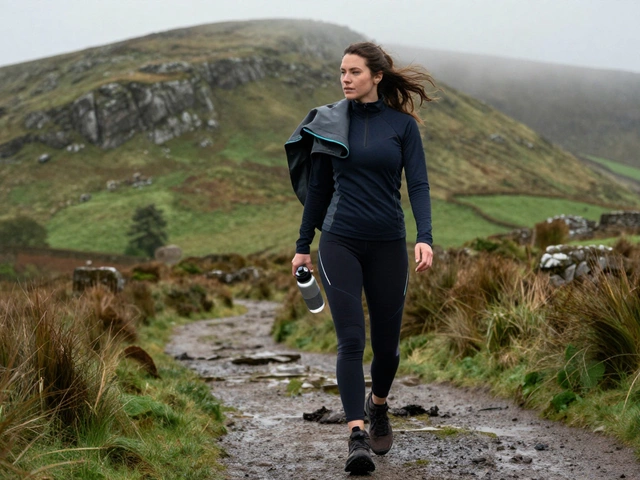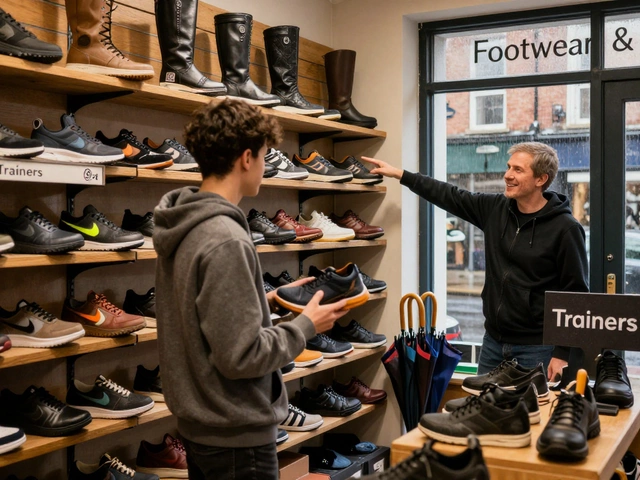5
What Do Americans Call T-Shirts? Irish Guide to US Clothing Lingo

Ever tried ordering a simple T-shirt online and found yourself accidently browsing for vests, polos, or something called a 'wife-beater'? If you’re in Ireland, this isn’t a rare moment—it’s part of the confusion brewed up by the language gap between the US and Irish markets. Americans toss about clothing terms that can seem a bit mad for anyone used to Irish or British fashion lingo. Yet with so many Irish shoppers ordering from US brands like Old Navy, Target, or even direct from independent Texan designers on Etsy, it pays to know what the yanks are actually on about.
The T-Shirt: Why Terms Differ Across the Atlantic
So here’s the thing: In the Irish market, a T-shirt is as plain as a hot press in a Galway house—short sleeves, round or crew neck, soft cotton or a cotton blend, keeps you cool in Knocknacarra or queueing for coffee in Dublin. But in the US, the term 'T-shirt' (yes, spelled with a hyphen for some, though more and more Americans drop it) means exactly the same thing—at least at the core. The simple crew-neck, short-sleeve, cottony top is what Americans and Irish folks both picture. Where it gets tangled is with all the nicknames, offshoots, and regional quirks.
For example, the American market took the classic T-shirt and spun it into a dozen variations: 'graphic tee' for designs or prints, 'V-neck' or 'crew neck' for neckline shapes, and specific names like ‘baseball tee’ for those with three-quarter sleeves in contrasting colours. Try asking for a “jersey” in Ireland and you’ll likely get pointed toward a GAA top or a rugby shirt, but in the States, ‘jersey’ sometimes means any sort of synthetic sport T-shirt—only context reveals if you’re talking about a football kit or a plain gym shirt.
But let’s move off the plain T-shirt for a second—because here’s where it gets spicy if you’re comparing terms before making a purchase. Both Irish and American shops split tees by subtle features, but use different names. The sleeveless T-shirt is called a ‘vest’ across Ireland. Ask for a vest in the US and folks will assume you mean a waistcoat (the sort you wear to a wedding, over a shirt). Instead, Americans will call it a ‘tank top,’ or if it’s ribbed, low-cut, and white, the unfortunate term “wife-beater” crops up—which, for anyone Irish, rightly sounds absolutely bananas and tasteless. Be aware: This phrase has a dodgy history, so best sidestep it in conversation.
If you’re a parent in Ireland doing a back-to-school shop for Penneys or Marks and Spencer local stores, you’ll know T-shirts by age category, sleeve length, and fit: slim-fit, regular, oversized. Much of this appears in American shops too, yet you’ll bump into “athletic fit” or “modern fit” for tighter cuts, especially from US sports-wear giants like Under Armour or Nike’s American site. Knowing this difference saves you from tee-shirt that fits like a sausage casing, or, on the flip, something baggy enough for the Galway Races parade.

Breaking Down American T-Shirt Lingo vs Irish
Now, let’s get under the collar—literally. The neckline is prime battleground for regional words. The crew neck is standard—what you see on nearly every T-shirt in Penneys, but in the States, you’ll spot V-neck, scoop neck, and boat neck in abundance. If you read 'scoop neck' on an American shop, picture a neckline dipping lower than the usual, something more revealing than what your mam would let you wear to mass.
Another thing where language gets twisted is with shirts and T-shirts. Anytime you hear ‘shirt’ in Ireland, it means a button-down, collared number. But Americans sometimes call T-shirts 'shirts' in casual speech—like, 'Grab that blue shirt for the barbecue.' This can make chat confusing, especially if you’re picking something up for a cousin now living in the Bronx. Don’t worry; context gives it away most of the time.
Sometimes, US brand terms trickle into Irish language. Walk into Urban Outfitters in Dublin or scroll Asos’s US-friendly pages and you might see 'tee' everywhere. Americans love to shorten everything—hence, 'tee' is now trendy lingo not just in LA but even among Dublin’s teens swapping jumpers for crop tops before Oxegen or Electric Picnic festival weekends. Even the big global names get in on the act—Nike, Adidas, and the like will call their Irish-market T-shirts ‘tees’ to cater for trend-led Irish shoppers, especially those scrolling Insta for looks from New York or Los Angeles.
A fun fact you’ll see crop up if you’re into fashion trivia: The T-shirt shape got the name because, well, if you lay it flat, the body and the arms form a big ‘T.’ Pretty simple, but it stuck all the way from early 1900s US soldiers’ uniform basics right into today’s wardrobe. In the Irish history books, the term popped up much later, mainly through American media and movies, especially with mid-century films. The likes of Marlon Brando and James Dean had the T-shirt looking like revolution in soft cloth—though Irish teens at the time had to wait before Penneys or Dunnes rolled them out in bulk.
Labels also matter, especially with US imports hitting shops in Liffey Valley or the Eyre Square Centre. 'Tagless' T-shirts often appear in US product blurbs—these are right up your alley if you can’t stand scratchy neck tags. The US market was actually the first big adopter of printed label instructions, something Irish manufacturers are only getting onboard with lately.
It can feel confusing when American brands get creative with naming. Some offer blended terms—a 'performance tee' isn’t what the average GAA player wears for Sunday kickabouts in the rain; it’s a T-shirt with moisture-wicking fabric (think working up a sweat on Salthill prom jogs). The Irish market is catching up with these sporty styles, especially with gyms and yoga studios popping up everywhere from Galway to Cork.

Shopping and Styling T-Shirts in the Irish Market
Here in Galway, summer can be soggy and the breeze unforgiving, so T-shirt shopping isn’t just about style—it’s about comfort layered under hoodies or jumpers year-round. If you’re ordering from the US, look out for random terms: 'longline tee' means extra length—so your midriff isn’t on show if the Atlantic gusts whip across Shop Street. A 'muscle tee' in American listings? That’s a sleeveless T-shirt with low-cut armholes—avoid unless you want to look like you’re off to a CrossFit class or starring in a Florida gym ad.
And when it comes to children’s wear, US sizing can be confusing. Their age brackets often start at '2T' (for two-year-olds), then '3T,' etc.—the 'T' stands for toddler. In Ireland, sizes are usually labeled simply by age. Be careful: A size 6 in American girls’ T-shirts may be very different than what Dunnes calls a 6. If you’re ever lost, check the sizing charts—most US stores give full measurement tables online. See the quick comparison below for reference:
| US Size | Irish/UK Size | Chest (cm) |
|---|---|---|
| 2T | 2-3 Years | 53 |
| 4T | 3-4 Years | 57 |
| 6 | 5-6 Years | 61 |
If you want to look sharp for work or gig nights, American shops offer 'dressy tees.' These can mean anything from T-shirts with lace, sequins, or metallic prints—so double-check the photo before ordering, lest you wind up wearing something flashier than a Rose of Tralee contestant. The Irish market’s catching up, especially at Brown Thomas or Avoca, so you might find similar styles labeled more modestly as ‘embellished tops.’
Don’t let all these terms put you off. The key thing to remember is most basics stay universal: short sleeves, crew neck, cotton. Just pay keen attention to sleeve length names ('cap sleeve' for very short, 'three-quarter' for sleeves ending between elbow and wrist), neckline, and any mention of 'fit.' Swerving the mistakes means less time queuing for returns at An Post and more time down the pub showing off your latest find from a New York streetwear site.
On the eco front, American brands have started offering more organic, recycled, or sustainable tees—Patagonia and Everlane are names to watch if you care about the environment. In Ireland, the likes of Fresh Cuts Clothing in Dublin are waving the flag for local, green-conscious options, so balance your basket between US and Irish brands if you can.
- Look up unfamiliar terms before buying—Google images are your friend.
- Check US sizing charts, especially with kids’ and women’s T-shirts.
- Avoid using 'wife-beater' (the American slang for a ribbed vest) in polite chat!
- Watch for fabric—US tees can be thinner, so layer against Galway chills.
- Enjoy experimenting—Irish style can mix and match American ideas with homegrown trends.
Next time you’re scanning rails in TK Maxx or flicking through a Chicago streetwear page, you’ll spot the terms straight away. Who knew a T-shirt could spin up so much cross-Atlantic banter? So arm yourself with a few words, an eye for quality, and maybe a Galway umbrella for your new tee. And don’t be surprised if your American cousin says ‘shirt’ when they really mean the humble T-shirt. Chalk it up to another Irish-American misunderstanding—like Americans loving tea but not knowing the difference between Barry’s and Lyons.






